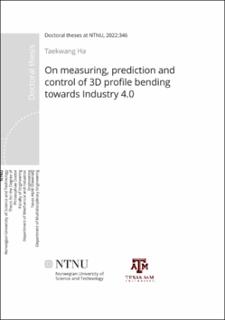| dc.contributor.advisor | Welo, Torgeir | |
| dc.contributor.advisor | Wang, Jyhwen | |
| dc.contributor.author | Ha, Taekwang | |
| dc.date.accessioned | 2023-02-28T11:23:45Z | |
| dc.date.available | 2023-02-28T11:23:45Z | |
| dc.date.issued | 2022 | |
| dc.identifier.isbn | 978-82-326-5601-1 | |
| dc.identifier.issn | 2703-8084 | |
| dc.identifier.uri | https://hdl.handle.net/11250/3054578 | |
| dc.description.abstract | Aluminum profile bending is one of the methods providing potential to reduce weight and improve fuel efficiency in automotive, aerospace, and other industries. Most of manufacturers make efforts to reduce the number of components and processing steps for manufacturing efficiency and to increase product quality. Two and three-dimensional shapes of products are also demanded to satisfy aesthetic perspectives.
To meet the industrial demands toward Industry 4.0, the current research mainly focuses on the development of the springback monitoring and control by non-contact measurement methods, analytic models and artificial neural networks. A new strategy for on-machine springback measurement in rotary draw bending was developed. The measurement strategy is to evaluate springback by integrating digital image processing and laser tracking, enabling the bending process and springback to be monitored in real time. As a non-contact measurement method, this affordable system eliminates an offline measurement process by integrative monitoring the springback angle in rotary draw bending.
Based on the digital image measurement strategy in rotary draw bending, an in-situ springback monitoring technique was also developed for stretch bending of large-size profiles. The measurement technique is to evaluate springback in real time. Using the so-called circular hough transform algorithm, the center of reference circles marked on the profile were detected, and springback was calculated. The applicability of computer vision-based springback monitoring in large-size profile bending was validated with experiments.
In advanced 3D stretch bending, a 5-axis machine was used to bend hollow aluminum alloy profiles. The method provides the capability of reduced springback for complex shapes. The configuration of the 3D bend die and its rotational mechanism were kinematically analyzed and an analytical springback model was proposed based on the Frenet-Serret theorem. While the kinematically controlled stretch bending imposes stretch through the configuration of the tool, super-imposed stretch applied prior to bending provides further springback reduction. Thus, the effect of the pre-stretch before bending was also explored in this work. The proposed model was validated with finite element simulations and experiments to demonstrate springback evaluation for product design and process control purposes.
To reduce springback variations and improve process control, an artificial neural network (ANN) model was developed. The ANN model was trained based on experimental and analytical data. This model provides compensated bending angles to achieve the desired dimensions of the product. The proposed strategy was validated with 2D and 3D stretch bending experiments and provided evidence to improve the dimensional quality of bent profiles. | en_US |
| dc.language.iso | eng | en_US |
| dc.publisher | NTNU | en_US |
| dc.relation.ispartofseries | Doctoral theses at NTNU;2022:346 | |
| dc.relation.haspart | Paper 1: Ha, Taekwang; Welo, Torgeir; Ringen, Geir; Wang, Jyhwen. A strategy for on-machine springback measurement in rotary draw bending using digital image-based laser tracking. The International Journal of Advanced Manufacturing Technology 2021 ;Volum 119. s. 705-718. This is an open access article under the CC BY licence. | en_US |
| dc.relation.haspart | Paper 2: Ha, Taekwang; Ma, Jun; Blindheim, Jørgen; Welo, Torgeir; Ringen, Geir; Wang, Jyhwen. A computer vision-based, in-situ springback monitoring technique for bending of large profiles. 24th International Conference on Material Forming; 2021-04-14 - 2021-04-16 This is an open access article under the CC BY licence. | en_US |
| dc.relation.haspart | Paper 3: Ha, Taekwang; Welo, Torgeir; Ringen, Geir; Wang, Jyhwen. On kinematics in sequential three-dimensional (3D) stretch bending: analytical springback model. This paper is submitted for publication and is therefore not included. | en_US |
| dc.relation.haspart | Paper 4: Ha, Taekwang; Welo, Torgeir; Ringen, Geir; Wang, Jyhwen. Smart control of springback in advanced stretch bending by an artificial neural network. This paper is submitted for publication and is therefore not included. | en_US |
| dc.title | On measuring, prediction and control of 3D profile bending towards Industry 4.0 | en_US |
| dc.type | Doctoral thesis | en_US |
| dc.subject.nsi | VDP::Teknologi: 500 | en_US |
| dc.description.localcode | Fulltext not available | en_US |

